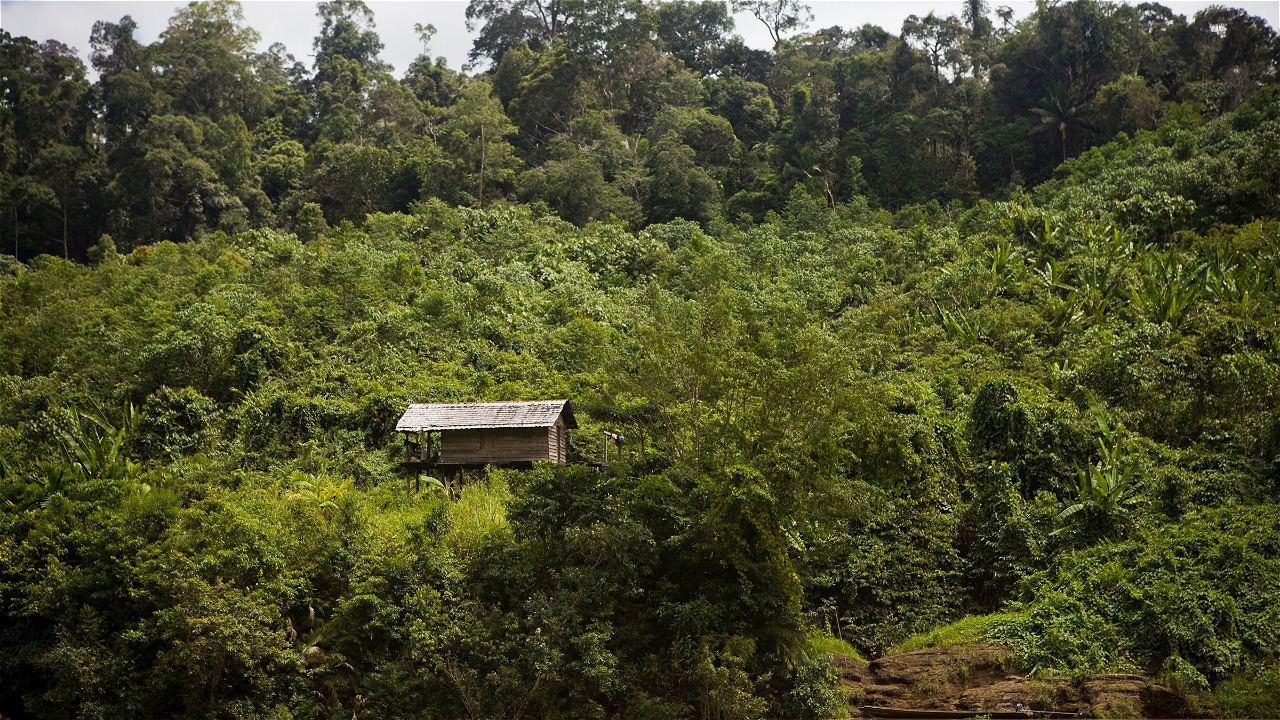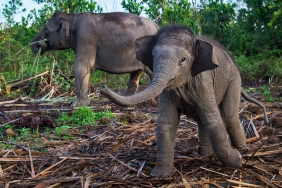WHY ARE FORESTS AND YARDS ACROSS THE ARCHIPELAGO INCREASINGLY DEVOID OF ANIMALS?
By: Sunarto
Tleguk..............................................................tleguk...tleguk..............tleguk................tleguk...........................tleguk..........tleguk......tleguk...tleguk..........tleguk...tleguktuktuktleguk tlegukguk gukgukgukgukgukuku....KA KA Ka Ka Ka Ka Ka Ka.......
That's the sound of a bird with the distinctive rhythm of an ivory-billed hornbill (Rhinoplax vigil). The rhythm begins with a slow, faint sound and then increases in tempo and tone. The tone climaxes with the sound of laughter that breaks the silence of the jungle. The sound is usually heard from the tops of the forest canopy in Sumatra and Kalimantan. He is one of 14 bird species of the Bucerotidae family (including hornbills, hornbills, julang and kangkareng) that live in Indonesia.
The sounds of the ivory-billed hornbill and many other bird and animal species are familiar to those who travel the jungles of the archipelago. Apart from the ivory hornbill, each bird species of the Bucerotidae family has its own distinctive sound, habitat preference and behavior. Rhinoceros hornbills (Buceros rhinoceros) that inhabit primary forests are often seen in male-female pairs and visit the forest's towering fruit trees. The bird with a red beak that rises like a rhino's horn is easily recognized because of the loud "GWAK....GWAK....GWAK" sound it usually emits when perched or flying. Meanwhile, smaller-bodied hornbill species such as the hornbill klihingan (Anorrhinus galeritus) generally live in groups in secondary forests and often make muted sounds.
According to world hornbill expert Yok Yok Hadiprakarsa, Indonesia ranks as the most important country for hornbill conservation in the world. This is not only because of the large number of species including endemic species that we have, but also because of the vast habitat available in our country for seed-spreading birds that are nicknamed forest farmers.
In addition to its unique sound, the large-bodied and broad-winged hornbill that reaches 1.5 meters in the case of the plank hornbill (Buceros bicornis), also makes a distinctive wing flapping sound "WHUSS WHUSS WHUSSSSSSSSS" when flying or hovering from one top to another canopy top.
Lonely Animals
Indonesia's healthy tropical forests are usually enlivened and colored by the various whims and fancies of the animals that live in them. The hornbill is one such feature. But it's not the only one. Even when morning has not yet broken, various primates such as gibbons (Hylobates sp), siamangs (Symphalangus syndactylus) and other primates have begun their activities with their distinctive screeches. Meanwhile, various birds are busy chirping to mark their territories.
The survival of wildlife cannot be separated from the existence of forests. And vice versa, forests need animals to care for plants through the dispersal of seeds from the fruits they eat, fertilization from the feces they excrete, pruning by herbivores, and various other important roles.
However, lately the various sounds of birds and animal inhabitants that used to enliven the atmosphere of forests throughout the country have slowly but surely become silent. I've noticed this in several locations I've visited in the past few months. One of my favorite places to visit is the Rimbang Baling Wildlife Reserve in Riau. I spent almost a week exploring the area at the end of 2015 with the WWF-KemenLHK animal monitoring team, and not a single hornbill could be heard. Neither were the kinds of songbirds that usually enliven the forest atmosphere.
In that trip, only a handful of them showed their existence. The others had either disappeared due to uncontrolled capture, or chose to stay quiet and hide for their safety from poachers. As a result, on that trip, the binoculars I brought were mostly just hanging around my neck or stashed in my backpack.
When I left the jungle, I was curious about the increasingly quiet situation of the forests that I had just experienced. Moreover, shortly after exploring Rimbang Baling, I received an invitation to visit Assam, India. What a contrast, where I was treated to animals that were not only abundant, but also easy to see. This was the case not only in protected areas such as Kaziranga National Park, but also along the way from the airport to people's yards. It was the locals who seemed to look at me strangely when I pointed my binoculars at the birds that didn't seem to be afraid of humans around their yards. In none of the neighborhoods did I see people keeping animals. Everything was free to fly or roam. It was only later that I learned that India has long practiced the principle and law that all wildlife should not be disturbed. The rule seems to have become ingrained and a habit of most if not all citizens to leave animals alone and not disturb them.
Unable to resist, I immediately shared my experience through social media about our forests and yards that are increasingly devoid of animals. To my surprise, many of my colleagues, especially birdwatchers, from various parts of the archipelago immediately responded to my complaint, confirming the same thing they felt. It is undeniable that we have not only lost many forests due to massive conversion and encroachment. Even the remaining forests are now increasingly quiet. As confirmed by my colleagues, this is happening not only in Sumatra, but also Java, Kalimantan, Sulawesi, Nusa Tenggara and Papua.
What is causing the jungles and all the green open spaces of the archipelago to become increasingly desolate from animals? It is hard to deny that uncontrolled poaching is the main cause. The results of monitoring in various places show the increasing activity of animal hunting, especially songbirds. This is also evident from camera trap photos from various regions, which are quite dominated by bird hunters and trappers. Even in villages on the edge of the forest, we can see that almost every house has cages filled with singing and non-singing birds.
Not to mention the traditional bird markets such as Pramuka, Barito and Jatinegar, as well as online stalls. As TRAFFIC reports, in just three days the survey team counted more than 19,000 birds of more than 200 species being traded in the three markets. Animal trafficking is very rampant in Indonesia. Brigadier General Yazid Fanani, Director of Special Crimes at POLRI, said that Indonesia is the number one country in Southeast Asia for [illegal] trade in wildlife.
It is clear that poaching has become a business that involves a wide network. According to Prince William, now a champion of animal conservation, transnational animal trafficking is one of the biggest illegal businesses, almost on par with drug trafficking, arms and human trafficking. With capital usually provided by urban financiers, poachers have become increasingly sophisticated in utilizing a variety of technologies that make it difficult for animals to evade capture and traps. From music players with clear sound systems with special recorded bird calls, GPS locator devices, portable collapsible poles, to fog nets and super-strength air guns whose use should be restricted and regulated, all seem to be freely obtained and used by bird hunters and trappers.
Birds and animals are not only being lost or silenced by uncontrolled hunting. They are also increasingly pressured and threatened by human activities such as logging and the collection of other forest products that continue to encroach on every corner of the jungle, to which access is now increasingly open. Across the archipelago, especially Sumatra and Kalimantan, there is now almost no forest area that is not visited by hunters, loggers and forest product pickers. Compared to animal sounds, the roar of chainsaws is now far more often heard and dominant in the great forests of the archipelago.
Suddenly Critical
Several factors contribute to the high intensity of poaching. The habit of keeping animals for entertainment or displaying their body parts as ornaments regardless of their status and origin, as well as fulfilling protein needs and ingredients for traditional medicines are some of the things that trigger high market demand that encourages hunting of animals in nature.
Poaching of the ivory hornbill, for example, has been driven by black market demand for the casque at the top of the bird's beak. The casque is traded because it can be carved for decoration like elephant ivory or used as an ingredient in traditional Chinese medicine. Massive poaching for consumption also occurs for other species such as pangolins.
According to Rangkong Indonesia's records, poaching of these animals began to appear rampant since around 2012. As reported in the IUCN Redlist, from just one province, West Kalimantan, around 6000 helmeted hornbills are illegally harvested per year. Not surprisingly, this animal seems to have disappeared immediately and may have experienced extinction in many places. Sadly, the victims of poaching are not only ivory hornbills. That's because many poachers misidentify their targets and just shoot any hornbill in sight.
Considering this phenomenon, in mid-2015, BirdLife International conducted a review of the animal's conservation status based on IUCN criteria which resulted in an increase in its status from "Near Threatened" or "Near Threatened" set in 2012, suddenly jumping three levels to "Critical" or "Critically Endangered" in 2015. This status is on par with that of some of Indonesia's iconic and rare large animals such as the Sumatran Tiger, Rhino, Sumatran Orangutan and Sumatran Elephant, all of which have long been recognized as critically endangered.
The ivory hornbill is not the only victim of over-exploitation and uncontrolled poaching. Previously, there has been rampant poaching of other protected wildlife, especially songbirds, turtles and pangolins.
Awareness and action
Poaching has reached a critical stage and has led to the local extinction of several songbird species in the wild. Due to rampant uncontrolled hunting in areas of high endemicity, Indonesia now tops the list of countries with the most threatened bird species, 131, in Asia. Songbird poaching is driven by high market demand. The deep-rooted culture of keeping songbirds, which continues to be encouraged through various competitions, is not matched by concern for the condition of animals in nature. If left unchecked, the mass extinction of our animals is on the horizon. The culture of loving animals should be nurtured and developed in accordance with the times. Without concern for the current condition of nature, it is not only birds and wildlife that are threatened by our over-exploitation.
Forests, which are needed for the survival of the earth's ecosystem, will lose their caretakers. In the end, humans will slowly but surely lose their life support.
Collective consciousness, behavioral changes, and restorative actions need to be promoted immediately to prevent the emptiness of life that we are heading towards. The silence of our forests, gardens and yards from the chirping of birds and the movements of animals is a thunderous warning to those who still have ecological sensitivity so that we all start caring for nature, where we are included in it.





